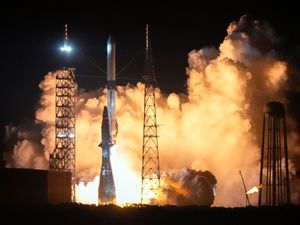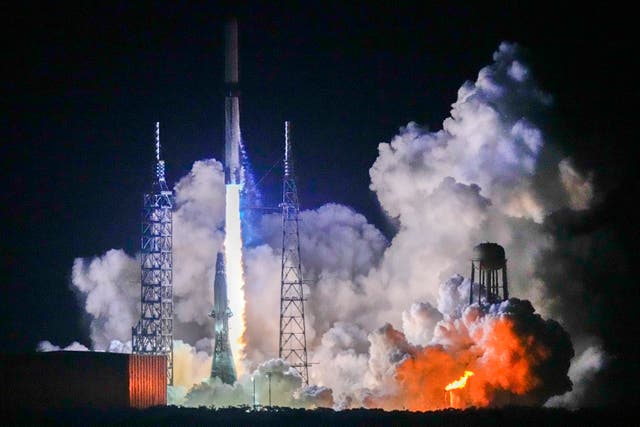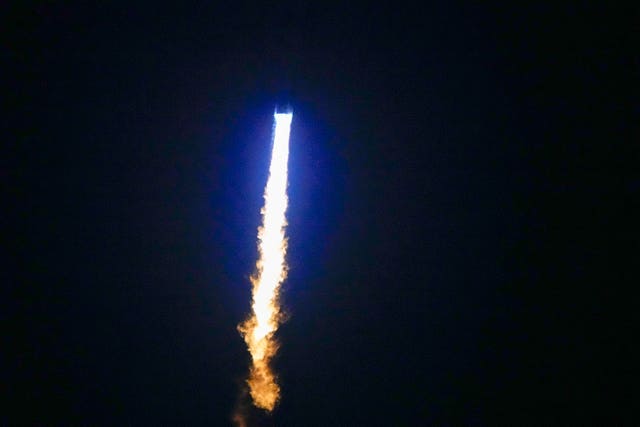Jeff Bezos’s Blue Origin launches new rocket on first test flight
Named after the first American to orbit Earth, the New Glenn rocket blasted off from Florida following a hold-up on Monday.

Blue Origin launched its massive new rocket on its first test flight on Thursday, sending up a prototype satellite to orbit thousands of miles above the Earth.
Named after the first American to orbit Earth, the New Glenn rocket blasted off from Florida, soaring from the same pad used to launch Nasa’s Mariner and Pioneer spacecraft half a century ago.
Years in the making with heavy funding by Amazon founder Jeff Bezos, the 320-foot (98-metre) rocket carried an experimental platform designed to host satellites or release them into their proper orbits.

All seven main engines fired at lift-off as the rocket blazed through the predawn sky to the delight of spectators lining nearby beaches.
Company employees erupted in cheers and frenzied applause once the craft successfully reached orbit 13 minutes later, a feat that drew quick praise from none other than SpaceX’s Elon Musk.
“We did it! Orbital,” Blue Origin’s chief executive Dave Limp said via X.
For this test, the satellite was expected to remain inside the second stage while circling Earth.
The mission was expected to last six hours, with the second stage then placed in a safe condition to stay in a high, out-of-the-way orbit in accordance with Nasa’s practices for minimising space junk.
The first-stage booster missed its landing on a barge in the Atlantic minutes after lift-off so it could be recycled, but the company stressed that the number one objective was for the test satellite to reach orbit.
Mr Bezos said before the flight it was “a little crazy” to even try to land the booster on the first try.
“What a fantastic day,” Blue Origin’s launch commentator Ariane Cornell, said.
New Glenn was supposed to fly before dawn on Monday, but ice build-up in critical plumbing caused a delay. The rocket is built to haul spacecraft and eventually astronauts to orbit and also to the Moon.
Founded 25 years ago by Mr Bezos, Blue Origin has been launching paying passengers to the edge of space since 2021, including himself. The short trips from Texas use smaller rockets named after the first American in space, Alan Shepard.
New Glenn, which honours John Glenn, is five times taller.
Blue Origin poured more than one billion dollars (£0.82 billion) into New Glenn’s launch site, rebuilding historic Complex 36 at Cape Canaveral Space Force Station.

The pad is nine miles (14km) from the company’s control centres and rocket factory, outside the gates of Nasa’s Kennedy Space Centre.
Mr Bezos — taking part in the launch from Mission Control — declined to disclose his personal investment in the programme. He said he does not see Blue Origin in a competition with Elon Musk’s SpaceX, long the rocket-launching dominator.
Blue Origin envisions six to eight New Glenn flights this year, if everything goes well, with the next one coming up this spring.
“There’s room for lots of winners,” Mr Bezos said from the rocket factory over the weekend, adding that this was the “very, very beginning of this new phase of the space age, where we’re all going to work together as an industry … to lower the cost of access to space.”
New Glenn is the latest in a series of big, new rockets to launch in recent years, including United Launch Alliance’s Vulcan, Europe’s upgraded Ariane 6 and Nasa’s Space Launch System or SLS, the space agency’s successor to the Saturn V for sending astronauts to the moon.
The biggest rocket of all, at approximately 400 feet (123 metres), is SpaceX’s Starship.
Elon Musk said the seventh test flight of the full rocket could occur later on Thursday from Texas. He hopes to repeat what he pulled off in October, catching the returning booster at the launch pad with giant mechanical arms.
Starship is what Nasa plans to use to land astronauts on the moon later this decade. The first two moon landings under the space agency’s Artemis programme, which follows the Apollo missions of the 1960s and 1970s, will see crews descending from lunar orbit to the surface in Starships.

Blue Origin’s lander, dubbed Blue Moon, will make its debut on the third lunar touchdown by astronauts.
Nasa administrator Bill Nelson pushed for competing moon landers similar to the strategy to hire two companies to ferry astronauts to and from the International Space Station.
Mr Nelson will step down when President-elect Donald Trump takes office on Monday.
Mr Trump has picked tech billionaire Jared Isaacman to run Nasa. Mr Isaacman, who has twice rocketed into orbit on his own privately financed SpaceX flights, must be approved by the Senate.
New Glenn’s debut was supposed to send twin spacecraft to Mars for Nasa. But the space agency pulled them from last October’s planned flight when it became clear the rocket would not be ready in time.
They will still fly on a New Glenn rocket, but not until the spring at the earliest. The two small spacecraft, named Escapade, are meant to study the Martian atmosphere and magnetic environment while orbiting the red planet.
Also on Thursday, India docked two satellites in space to become the fourth nation in the world to achieve the mission, officials said, in an ambitious milestone in its expansion of space technology.
The Indian Space Research Organisation, or ISRO, manoeuvred back together the two satellites, weighing 220 kilograms (485 pounds) each, during a “precision” space docking experiment, known as SpaDeX, the space agency said.
It called the operation as a “historic moment”.
In December, the satellites, Chaser and Target, blasted off on a single rocket from the Sriharikota launch site.
“India docked its name in space history!” the ISRO said in a post on social media site X. “Post docking, control of two satellites as a single object is successful.”
The mission was postponed twice earlier because of technical issues.
Prime Minister Narendra Modi congratulated Indian scientists on the successful mission. “It is a significant stepping stone for India’s ambitious space missions in the years to come,” he said on X.
The successful mission, earlier achieved by only the Soviet Union, the United States and China, showcased India’s rising standing as a technology and space powerhouse and dovetails with its desire to project an image of an ascendant country asserting its place among the global elite.
In 2023, Mr Modi said that India’s space agency will set up an Indian-crafted space station by 2035 and land an Indian astronaut on the moon by 2040.
Active in space research since the 1960s, India has launched satellites for itself and other countries, and successfully put one in orbit around Mars in 2014.
After a failed attempt to land on the moon in 2019, India became the first country to land a spacecraft near the moon’s south pole in 2023 in a historic voyage to uncharted territory that scientists believe could hold vital reserves of frozen water.
The mission was dubbed as a technological triumph for the world’s most populous nation.





